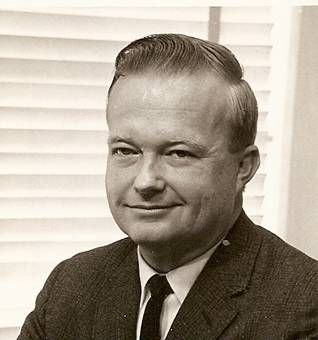

RICHARD D. VAUGHAN, P.E.
Assistant Surgeon General
Rear Admiral, USPHS (ret.)
Richard Dugger Vaughan, known to his friends as “Dick”, was born in Evanston, Illinois on December 18, 1926. He spent his early life in Evanston, Illinois, Miami, Florida and Silver Spring, Maryland. After graduating from high school in 1944 he joined the U.S. Army, serving during the latter part of World War II.
In 1951 Dick Vaughan married the former Laura May Henderson of Sarasota, Florida. They had three children, Cynthia, Robert, and Kathryn.
In 1950, Vaughan began his professional work, when as a Co-op student at Georgia Tech he was assigned to the Public Health Service’s Communicable Disease Center (CDC) Field Training Station in Columbus, Georgia. That station was engaged in the field training of state and local sanitarians, sanitary engineers and other public health disciplines in basic sanitation and environmental engineering.
In June 1951, Vaughan was awarded a Bachelor of Civil Engineering degree from Georgia Institute of Technology. Upon graduation he was commissioned as an Ensign in the Commissioned Corps of the U.S. Public Health Service (PHS) and was assigned back to the CDC Field training station in Columbus, Georgia. After a six-month period at Columbus, he was assigned by CDC to the Texas State Health Department in Austin, Texas as a training officer, where he helped plan and conduct training courses in insect and rodent control for sanitarians, engineers and pest control operators. While there he also helped edit and write several chapters of the Texas Sewage Treatment Plant Operator's manual. During that assignment he served as an engineering member of the State Epidemiological Surveillance Team, which was active during disease outbreaks. While serving in Texas, he was detailed to the Indian Health Service (IHS) in Phoenix, Arizona where he assisted in the training of American Indian sanitarians.
In 1953, Vaughan was reassigned by CDC to Oklahoma City, Oklahoma to assist with professional training activities of the Oklahoma State Health Department. There he established and helped conduct an environmental health in-service training program designed to provide certification for sanitarians.
In 1956, Vaughan was transferred to the PHS Water Pollution Control program at the Dallas, Texas Regional Office to serve as a staff engineer. This was during the initial year of the PHS Construction Grants program designed to assist local municipalities in the enhancement of sewage treatment facilities. In 1958, he was assigned duties as the Assistant Director of the Arkansas-Red River Basin Water Quality Conservation Project.
In 1962, as part of a PHS training assignment, Vaughan was assigned to the University of Michigan where he received both a Master of Civil Engineering degree and a Master of Public Health degree.
Upon his completion of his academic work at the University of Michigan in 1962, Dick Vaughan was assigned to the post of Director of the Detroit River-Lake Erie Enforcement Project to plan and conducted a comprehensive study of the Detroit River and Western Lake Erie. A major focus of that study was to locate sources of water pollution and recommend corrective measures to improve water quality and protect public health. At the completion of the study in 1964, all of the recommendations resulting from the study were agreed to by the municipalities and industries involved.
In 1964, Vaughan was transferred to Ada, Oklahoma, to serve as the first Director of the Robert S. Kerr Water Research Center, where he was responsible for the construction of the research center facility and its initial staffing. In 1966 the responsibility for the Federal Water Pollution Control Program was transferred from the PHS, Department of Health, Education and Welfare, to the United States Department of the Interior. Vaughan was transferred from his Oklahoma post to the newly created PHS Solid Waste Program in Washington, D.C., where he was put in charge of the Federal Demonstration Grants Program. He later became responsible for the General Sanitation Program and then was made Director of the Bureau of Solid Waste Management in Rockville, Maryland. In 1968 the solid wastes program became part of the newly created PHS Consumer Protection and Environmental Health Service.
In 1970 when environmental activities were transferred from the Department of Health, Education and Welfare to the Environmental Protection Agency (EPA), he was appointed as head of the Federal Solid Waste and Hazardous Waste program at EPA. In December of 1970 he was promoted to Assistant Surgeon General with the rank of Rear Admiral (RADM).
RADM Vaughan retired from the PHS in August 1971. He worked for two years as a consulting civil engineer in the Washington, D.C. area and then in 1973 he joined the ITT Corporation to assume responsibilities for the Corporation’s environmental affairs, quality assurance and safety programs. In that post he acted as the Corporation’s liaison with State and Federal agencies in all environmental matters. He also served as a consultant to ITT Corporate Headquarters in their efforts to improve environmental compliance in all ITT units.
In 1986, RADM (ret.) Vaughan retired from ITT and became active in volunteer work in Ormond Beach and Volusia County, Florida. He served as Chairman of the City of Ormond Beach Environmental Advisory Board. He also served two terms as President of the Community Theatre and as President of the classical Music Society and as Commodore of the local Yacht Club,
During his PHS career Vaughan was awarded the PHS Commendation Medal, the PHS Meritorious Service Medal and the National Defense Service Medal. He is a Registered Professional Engineer in the state of Texas and a Diplomate in the American Academy of Environmental Engineering.
RADM (ret.) Vaughan and his wife reside in Ormond Beach, Florida.
July 2008
Back to History of USPHS Engineers